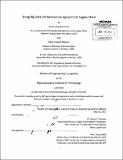| dc.contributor.advisor | Bruce C. Arntzen. | en_US |
| dc.contributor.author | Smith, Derik Lafayette | en_US |
| dc.contributor.author | Dhavala, Satya Prakash | en_US |
| dc.contributor.other | Massachusetts Institute of Technology. Engineering Systems Division. | en_US |
| dc.date.accessioned | 2013-09-24T19:43:13Z | |
| dc.date.available | 2013-09-24T19:43:13Z | |
| dc.date.copyright | 2013 | en_US |
| dc.date.issued | 2013 | en_US |
| dc.identifier.uri | http://hdl.handle.net/1721.1/81106 | |
| dc.description | Thesis (M. Eng. in Logistics)--Massachusetts Institute of Technology, Engineering Systems Division, 2013. | en_US |
| dc.description | Cataloged from PDF version of thesis. | en_US |
| dc.description | Includes bibliographical references (p. 53-54). | en_US |
| dc.description.abstract | Agriculture is an industry where historical and current data abound. This paper investigates the numerous data sources available in the agricultural field and analyzes them for usage in supply chain improvement. We identified certain applicable data and investigated methods of using this data to make better supply chain decisions within the agricultural chemical distribution chain. We identified a specific product, AgChem, for this study. AgChem, like many agricultural chemicals, is forecasted and produced months in advance of a very short sales window. With improved demand forecasting based on abundantly-available data, Dow AgroSciences, the manufacturer of AgChem, can make better production and distribution decisions. We analyzed various data to identify factors that influence AgChem sales. Many of these factors relate to corn production since AgChem is generally used with corn crops. Using regression models, we identified leading indicators that assist to forecast future demand of the product. We developed three regressions models to forecast demand on various horizons. The first model identified that the price of corn and price of fertilizer affect the annual, nation-wide demand for the product. The second model explains expected geographic distribution of this annual demand. It shows that the number of retailers in an area is correlated to the total annual demand in that area. The model also quantifies the relationship between the sales in the first few weeks of the season, and the total sales for the season. And the third model serves as a short-term, demand-sensing tool to predict the timing of the demand within certain geographies. We found that weather conditions and the timing of harvest affect when AgChem sales occur. With these models, Dow AgroSciences has a better understanding of how external factors influence the sale of AgChem. With this new understanding, they can make better decisions about the distribution of the product and position inventory in a timely manner at the source of demand. | en_US |
| dc.description.statementofresponsibility | by Derik Lafayette Smith and Satya Prakash Dhavala. | en_US |
| dc.format.extent | 54 p. | en_US |
| dc.language.iso | eng | en_US |
| dc.publisher | Massachusetts Institute of Technology | en_US |
| dc.rights | M.I.T. theses are protected by
copyright. They may be viewed from this source for any purpose, but
reproduction or distribution in any format is prohibited without written
permission. See provided URL for inquiries about permission. | en_US |
| dc.rights.uri | http://dspace.mit.edu/handle/1721.1/7582 | en_US |
| dc.subject | Engineering Systems Division. | en_US |
| dc.title | Using big data for decisions in agricultural supply chain | en_US |
| dc.type | Thesis | en_US |
| dc.description.degree | M.Eng.in Logistics | en_US |
| dc.contributor.department | Massachusetts Institute of Technology. Engineering Systems Division | |
| dc.identifier.oclc | 858278881 | en_US |
